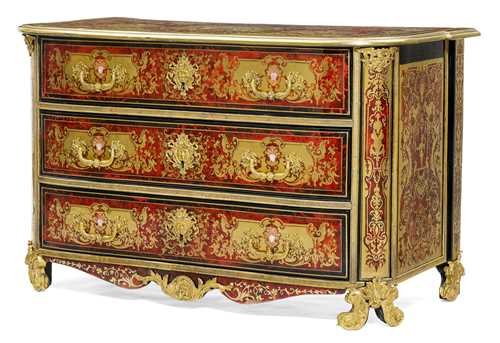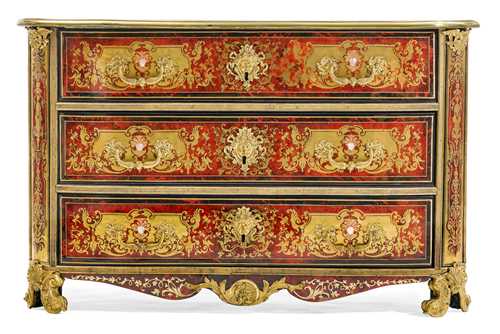
Lot 1044 ♣ - A200 Decorative Arts - Thursday, 31. March 2022, 10.00 AM
COMMODE WITH BOULLE MARQUETRY
Louis XIV, Paris ca. 1710, probably by Nicolas Sageot (1666-1731, maître 1706).
Pinewood and walnut core, inlaid with red tortoiseshell, engraved brass and mother-of-pearl, copper, tin and horn, polychrome painted with tendrils and scrolls, mythical animals and depictions of figures "in the manner of Jean Bérain". Rectangular body, on scrolled feet with opulent bronze mounts. The top is edged in brass and opulently decorated with arabesques, tendrils, mascarons, birds, garlands, people playing music, dancing people, and insects, and three opulently decorated reserves. Front with three drawers. Opulent bronze mounts, designed as heads of women, shells, leaves, mascarons and engraved rods. 1 key.
132 × 67.5 × 81 cm.
For the exportation of this item a CITES license is required. Prospective buyers should familiarize themselves with relevant customs regulations prior to bidding if they intend to import this lot into another country. For further information please contact the department.
Marquetry restored, with some fillings and extensive restorations. The engravings in part worn off. Gilding of the bronze applications, in part later. The escutcheons probably from the 19th century.
Nicolas Sageot was born in Sermaize-en-Champagne in 1666 and died in Paris on 8 January 1731. In 1711, he married the daughter of the ebeniste Jacques Roussel. His work has only recently been discovered and researched. After Sageot established himself as a freelance craftsman in the Faubourg Saint-Antoine area in the last decade of the 17th century, he became a master cabinetmaker in 1706. His workshop was located opposite the Bastille, at the intersection of the large rue du Faubourg Saint-Antoine and the rue de la Roquette, where the entrance of his store "Soufflet Royal" was. His workshop was, like that of André-Charles Boulle, one of the most developed towards the end of the reign of Louis XIV and the Régence. Sageot's main works are part of the collections of the Musée National du Château de Versailles, the Musée du Petit Palais in Paris, the Museum of Champs Castle, the Royal Palace in Stockholm, the National Museet in Stockholm, the Bavarian National Museum in Munich, the Ansbach Residenzmuseum, the Victoria & Albert Museum, the Wallace Collection in London, the Rijksmuseum in Amsterdam, and the Musée de l'Ermitage in Saint Petersburg. Four signed items of furniture by Sageot are known to exist.
Nicolas Sageot was born in Sermaize-en-Champagne in 1666 and died in Paris on 8 January 1731. In 1711, he married the daughter of the ebeniste Jacques Roussel. His work has only recently been discovered and researched. After Sageot established himself as a freelance craftsman in the Faubourg Saint-Antoine area in the last decade of the 17th century, he became a master cabinetmaker in 1706. His workshop was located opposite the Bastille, at the intersection of the large rue du Faubourg Saint-Antoine and the rue de la Roquette, where the entrance of his store "Soufflet Royal" was. His workshop was, like that of André-Charles Boulle, one of the most developed towards the end of the reign of Louis XIV and the Régence. Sageot's main works are part of the collections of the Musée National du Château de Versailles, the Musée du Petit Palais in Paris, the Museum of Champs Castle, the Royal Palace in Stockholm, the National Museet in Stockholm, the Bavarian National Museum in Munich, the Ansbach Residenzmuseum, the Victoria & Albert Museum, the Wallace Collection in London, the Rijksmuseum in Amsterdam, and the Musée de l'Ermitage in Saint Petersburg. Four signed items of furniture by Sageot are known to exist.
CHF 80 000 / 120 000 | (€ 82 470 / 123 710)
Sold for CHF 134 500 (including buyer’s premium)
All information is subject to change.






